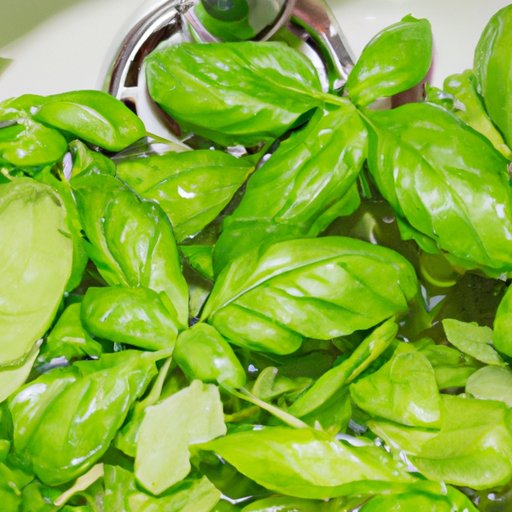I. Introduction
Fresh basil is a versatile herb that can add a touch of flavor and freshness to your dishes. However, many of us have faced the challenge of basil wilting quickly and losing its taste. In this article, we explore how to store fresh basil to keep it fresh for longer, so you can have flavorful and aromatic basil whenever you want.
II. Understanding the basics of basil storage
Basil is a delicate herb, and its leaves can wilt and go bad quickly if not stored correctly. The compounds in basil that give it its distinct aroma and flavor are volatile and can easily evaporate. Furthermore, the enzymes in basil can quickly break down the essential oils, causing the leaves to lose their flavor and aroma.
The freshness of basil is affected by various factors, including temperature, moisture, and air exposure. Basil leaves need to be kept dry, and humidity or moisture can make them go bad. Air exposure can also cause basil leaves to wilt, so it’s essential to minimize air contact and keep the leaves in an airtight container.
III. Best practices for handling and storing fresh basil
Proper handling is critical to keep basil fresh. When selecting fresh basil, choose bright, fragrant leaves that are uniform in color and free from visible signs of decay or damage. Also, avoid wilted leaves and yellowing.
After choosing fresh basil, wash it gently under running water to remove any dirt or debris and pat it dry with paper towels. Once dry, carefully wrap the basil in a damp paper towel to keep it moist. Store the basil wrapped in the paper towel in a plastic bag with a few pinpricks to allow for airflow. Place the bag in the refrigerator’s crisper drawer to keep the temperature and humidity level stable.
IV. Storage methods for fresh basil
There are various methods to store fresh basil, and each has its own set of requirements and benefits.
Refrigeration: Storing fresh basil in the refrigerator is one of the most popular ways to keep it fresh. Make sure to keep the basil wrapped in the damp paper towel in an airtight container or plastic bag. The ideal temperature for basil storage is around 40°F, and it can last for up to a week in the refrigerator.
Water storage: Another way to keep basil fresh is to store it in water like cut flowers. Trim the basil stems and place them in a glass jar filled with water, making sure the leaves are above the water level. Keep the jar at room temperature and change the water every day to prevent it from turning brown. Basil stored in water can last up to a week.
Freezing: Freezing fresh basil is an excellent option if you want to store it for an extended period. Blanch the basil leaves for a few seconds in boiling water, then shock them in ice water to stop the cooking process. Pat them dry and freeze them in a single layer on a baking sheet. Once frozen, transfer them to an airtight container or freezer bag, making sure to remove any excess air. Frozen basil can last up to six months.
Drying: Drying fresh basil is a traditional way of storing it. Tie the basil stems with a string and hang them upside down in a warm, dry, and well-ventilated area. Once the leaves are dry, strip them from the stem and store them in an airtight container in a cool, dry place. Dried basil can last for up to a year.
V. Tips for extending the shelf life of fresh basil
Aside from storage, there are different ways to prolong the freshness of basil.
One way is to use fresh basil in recipes that don’t require cooking or heat. For example, you can make a basil salad or add fresh basil to sandwiches, pizza, and more.
Another way is to preserve leftover basil by making basil pesto, infused oils, or freezing it into ice cubes for future use.
VI. Conclusion
Storing fresh basil can be tricky, but following these storage techniques and tips can help you keep your basil fresher for longer. Remember to handle it carefully, choose the right storage method, and use it in ways that can maximize its shelf life. With these steps, you can always have fresh and fragrant basil to add to your dishes.
